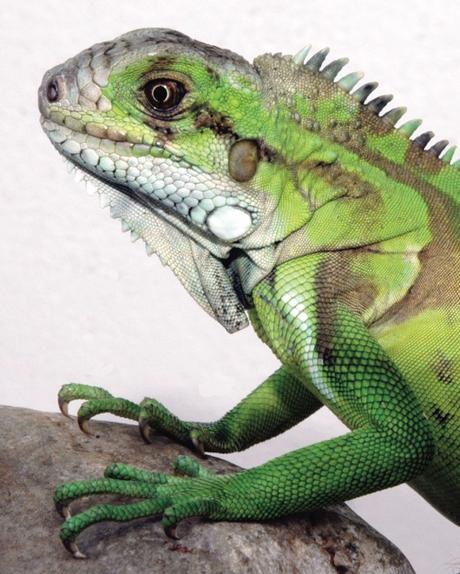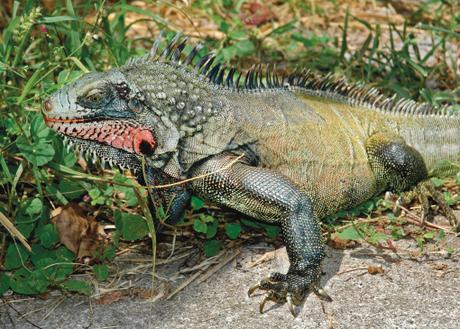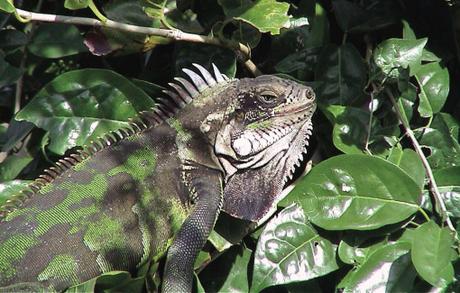In our latest study, we examine the downstream effects of publicising an elevated species description for a reptile that is highly prized in the international commercial wildlife trade.

We describe how iguanas from an insular population of the common green iguana (Iguana iguana) entered commercial trade shortly after an announcement was made indicating that the population would be described as a new species.
The international commercial wildlife trade presents a known risk factor for wild populations of threatened species. One organisation in particular regulates the international trade in species — the Convention on International Trade in Endangered Species of Wild Fauna and Flora (CITES).
Although most people probably know about the illegal practices involving iconic elephants and rhinos, reptiles are also targeted and traded. For example, after its discovery and description in 2016, and even though locality data were safeguarded, China’s endemic Mountain spiny crocodile newt (Echinotriton maxiquadratus) quickly entered the trade. This put conservation pressure on this small-range species (1, 2). Therefore, CITES signatory countries placed this species on its Appendix II in 2019, which lists animals and plants in need of protection.
Saba, an overseas island territory of the Netherlands in the Caribbean’s West Indies, has long been considered within the natural range of the common green iguana (Iguana iguana) (3). In 2011, the Saba Conservation Foundation publicly announced that a scientific study was underway to establish the Saba black iguana as a distinct species (Iguana melanoderma) only found on Saba.
Soon after this news was widely shared ‘Saba black dragons’ appeared for sale by high-end commercial hobbyists and reptile dealers. This was odd because we found that the Saba CITES authority had never issued export permits for the species, which led us to investigate the origins of these animals. Commercial reptile dealers informed us that such black iguanas were being exported from Sint Maarten (neighbouring island and also part of the Dutch Kingdom) and the island nation of Barbados.
While a Common green iguana can be sold today by a reptile dealer in the United States for US$50.00, currently a pair of ‘Saba Island black dragon green iguanas’ is being offered for sale for a few thousand dollars. For those wondering if this horse (iguana) has bolted from the barn, it has.

Indeed, through the CITES database we found that iguanas have been exported from both Sint Maarten and Barbados, which is interesting to say the least because those islands are only inhabited by non-native populations of common green iguanas, which are generally of low commercial value. (4, 5). So why were people selling iguanas from these two islands?
Although we asked for copies of export permits issued by authorities on Sint Maarten and Barbados, both islands refused. The St. Maarten authority, instead of being concerned over potential illegal activities, questioned the validity of our findings, insisting their permits were reliable unless the exported animals were genetically identified as originating from Saba. Conversely, Barbados indicated that after receiving training in CITES wildlife trade-law enforcement, they “no longer” issue export permits for iguanas.
Given multiple lines of evidence, our study concluded that the illegal trade in Saba iguanas was facilitated through either false claims of captive breeding and/or successful breeding of trafficked parental stock on Sint Maarten and Barbados. Additionally, we concluded that inappropriately issued CITES export permits have facilitated this trade, which effectively laundered the newly elevated species (4) into the commercial trade.
Illegal trade in the Saba iguana is no doubt made easier because hatchlings are extremely difficult to distinguish from the regularly — and legally — traded common green iguana; Customs officers and inspectors would face a difficult task conclusively identifying trafficked animals.
What is unique about this case is that the commercial interest in the Saba iguana was stimulated not by its elevation to a full species, but instead by the social media announcement from 2011 (repeated by commercial dealers) and upcoming research statements in later studies (5). We are not aware of similar instances in which merely the suggestion of the existence of a cryptic species would so stimulate trafficking.

Interestingly, the CITES Conference of the Parties recently sought to address the issuance of permits for trafficked animals and/or their offspring by adopting a new interpretive document encouraging CITES countries to scrutinize more strictly the legal origins of animals prior to issuing export permits (see CITES Conf. Resolution 18.7 Legal Acquisition Findings). Ironically, one of the drivers for the development of this more stringent guidance was the illegal and irregular trade in other Caribbean iguanas — such as Cyclura rock iguanas.
In our paper, we offer involved CITES authorities and the CITES Secretariat recommendations to combat wildlife trafficking and to ensure that CITES permits are not issued for trafficked animals and/or their offspring (6).
These include issuing CITES zero export quotas for the elevated species, better inter-island coordination, and increased attention to ‘legal acquisition findings’, which serve as the legal foundation for the entire CITES Appendix II trade system.
Many species the world over remain to be described scientifically. While our recommendations focus on Saba’s iguanas, certainly the principles and practices should be used widely for other species and circumstances.
- Bruce J. Weissgold ([email protected])
- Matthijs P. van den Burg ([email protected])
References
- Rowley, JJL et al. (2016). Estimating the global trade in Southeast Asian newts. Biol. Conserv. 199: 96-100
- IUCN & TRAFFIC (2019). IUCN/TRAFFIC Analyses of the Proposals to Amend the CITES Appendices. Prepared by IUCN Global Species Programme and TRAFFIC for the Eighteenth Meeting of the Conference of the Parties to CITES. IUCN – International Union for Conservation of Nature, Gland, Switzerland
- Stephen, CL et al. (2013). Geographical structure and cryptic lineages within common green iguanas, Iguana iguana. J. Biogeogr. 40: 50-62.
- Bock, B et al. (2018). Iguana iguana. The IUCN Red List of Threatened Species 2018: e.T174481A1414646
- van den Burg, MP et al. (2018). The lesser Antillean iguana (Iguana delicatissima) on St. Eustatius: genetically depauperate and threatened by ongoing hybridization. J. Hered. 109: 426-437
- Breuil, M et al. (2020). Painted black: Iguana melanoderma (Reptilia, Squamata, Iguanidae) a new melanistic endemic species from Saba and Montserrat islands (Lesser Antilles). ZooKeys 926: 95-131
- Breuil, M. (2013). Morphological characterization of the common iguana Iguana iguana (Linnaeus, 1758), of the Lesser Antillean iguana Iguana delicatissima Laurenti, 1768 and of their hybrids. English translation by the International Reptile Conservation Foundation (IRCF) pp. 1-37
- van den Burg, MP & Weissgold, BJ. (2020). Illegal trade of morphologically distinct populations prior to taxonomic assessment and elevation, with recommendations for future prevention. J. Nat. Conserv. 57: 125887

